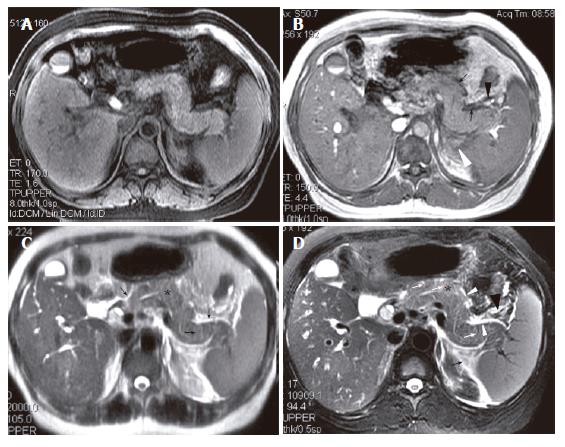Copyright
©2006 Baishideng Publishing Group Co.
World J Gastroenterol. Sep 28, 2006; 12(36): 5859-5865
Published online Sep 28, 2006. doi: 10.3748/wjg.v12.i36.5859
Published online Sep 28, 2006. doi: 10.3748/wjg.v12.i36.5859
Figure 1 A 42-year-old woman with interstitial edematous pancreatitis.
A: SPGR fat-suppressed T1-weighted (TR/TE = 170/1.6 ms) image shows pancreatic signal intensity comparable to that of liver; B: GRE in-phase (TR/TE = 150/4.4 ms) image shows pancreatic fascial plane (arrows) and peripancreatic fat stranding (arrow heads); C: SSFSE T2-weighted (TE = 90 ms) image shows increased pancreatic signal intensity (asterisk). Stranding in the pancreatic fascial plane (large arrow) and peripancreatic fat and thickened pancreatic lobular septum (small arrow) can also be seen; D: R-T T2-weighted (TR/TE = 11 800/93 ms) image shows above findings much better (Asterisk indicates pancreatic parenchyma, white arrows indicate thickened pancreatic lobular septum, white arrow head indicates pancreatic fascial plane, and black arrow and arrow head indicate fat stranding).
- Citation: Zhang XM, Feng ZS, Zhao QH, Xiao CM, Mitchell DG, Shu J, Zeng NL, Xu XX, Lei JY, Tian XB. Acute interstitial edematous pancreatitis: Findings on non-enhanced MR imaging. World J Gastroenterol 2006; 12(36): 5859-5865
- URL: https://www.wjgnet.com/1007-9327/full/v12/i36/5859.htm
- DOI: https://dx.doi.org/10.3748/wjg.v12.i36.5859









